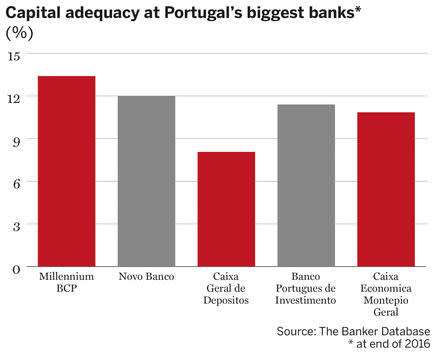Among the four countries to finish assistance programmes provided by the European Stability Mechanism – better known as the EU bailout fund – Portugal’s recovery has been the most sluggish.
Its performance has been overshadowed by the Spanish employment rate, which has grown three percentage points in two years; Ireland’s ability to lure post-Brexit business from the UK; and Cyprus’s growth in gross domestic product – the second fastest in Europe.
However, the economy has performed strongly during the first half of 2017; now its banking sector needs a similar reversal. Sector-wide losses ballooned from $391m to $3.65bn in 2016, while the capital cushions at its biggest banks have also shrunk.

Caixa Geral de Depositos, historically Portugal’s biggest bank, now ranks third after Tier 1 capital shrank 43% last year, leaving it with a risk-weighted capital adequacy ratio of just 8.07%. It is the subject of a €5bn recapitalisation package being thrashed out by EU and Portuguese authorities.
Millennium BCP is now the country’s leading bank, and despite its Tier 1 base diminishing 18%, its 13.4% capital adequacy ratio is the healthiest among Portugal’s biggest lenders. Novo Banco, which owns the remnants of failed lender Espírito Santo, ranks second despite its Tier 1 base shrinking 23%. Its capital adequacy ratio is moderately lower at 12%.
In fourth and fifth place, Banco Portugues de Investimento and Caixa Economica Montepio Geral have grown their capital base between 3.5% and 5%. Their capital ratios are 11.4% and 10.85%, respectively.
By comparison, the capital ratios of Spain’s top five banks are between 13.8% and 16.2%, while in Cyprus they range from 14.6% to 30%, and in Ireland from 14% to 22%.
All data sourced from www.thebankerdatabase.com






